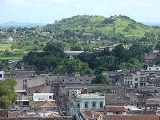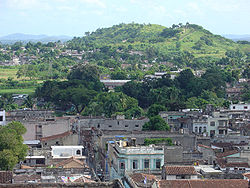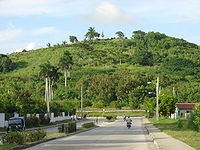
Loma del Capiro
Encyclopedia
Loma del Capiro is a group of three small peaks located in the city of Santa Clara
, Cuba
.
 The elevation gained local and worldwide historic significance after Che Guevara
The elevation gained local and worldwide historic significance after Che Guevara
used it as hideout and command center to invade the city in a battle known as Battle of Santa Clara
during the Cuban Revolution
. With an altitude of 176.6 m (579.4 ft), the smallest peak holds the name of Capiro and next to it, with 185.9 and 188.4 meters tall are twin peaks known as Dos Hermanas (Two sisters). A monument commemorating the battle was placed at the top of the smallest peak. A lookout is located close to it, providing a view of the city, the savanna filled with royal palms and farms. The natural surroundings provide shelter to endemic vegetation and a plantation of Santa Clara's tree, the tamarind
sits on the South side of it.
 With a strategic location overlooking the city, the hill was decisive for the rebels in their quest to take down the Batista
With a strategic location overlooking the city, the hill was decisive for the rebels in their quest to take down the Batista
regime in 1959. Boasting an army airport, Santa Clara city had several garrisons, numerous troops, mortars tanks and air support. Che Guevara initially estimated that taking over the city would take around two months of fighting. A key action in the very beginning of the battle made it happen in just a few days. Che intercepted an armored train filled with weapons passing the skirts of Capiro hill. The train was derailed and using Molotov cocktail
s against its metal walls the soldiers inside didn’t stand a chance against the heat and gave up. A museum and monument of the armored train action stands near the hill today. With all the new armament the rebels began gaining positions inside the city. Once Santa Clara was in the hands of the rebel force, Batista fled Cuba from Havana, never to return again and the Revolution triumphed that very day.
 Aside from the great historic importance of Capiro hill, there’s also a great natural, scientific and tourist interest attached to these hills, unfortunately these others features are completely unknown to locals and visitors.
Aside from the great historic importance of Capiro hill, there’s also a great natural, scientific and tourist interest attached to these hills, unfortunately these others features are completely unknown to locals and visitors.
A witness of the Chicxulub impact
In an article released in GeoScienceWorld in September 2005 by Laia Alegret is described how the author researched the sediments at Loma Capiro in Central Cuba and provided new evidence about the Chicxulub impact
. The Chicxulub impact refers to the huge meteor that hit the Yucatán Peninsula in the Cretaceous
/Paleogene
era and is believed to have played a major role in the mass extinction of the dinosaurs. During impact, mega tsunamis, earthquakes and continental destabilization were generated. It affected Cuba in particular, due to the proximity and elongated shape of the island.
A natural shelter
Many endemic species of the Cuban savanna and forests can be found on the north slope of the site, while in the south, a plantation of Tamarind trees was started decades ago. This is the symbolic tree of Santa Clara city, representing its foundation. This plantation helps prevent slope erosion and provides fruit for the nearby community.

Santa Clara, Cuba
Santa Clara is the capital city of the Cuban province of Villa Clara. It is located in the most central region of the province and almost in the most central region of the country.- History :Santa Clara was founded by 175 people on July 15th, 1689...
, Cuba
Cuba
The Republic of Cuba is an island nation in the Caribbean. The nation of Cuba consists of the main island of Cuba, the Isla de la Juventud, and several archipelagos. Havana is the largest city in Cuba and the country's capital. Santiago de Cuba is the second largest city...
.

Che Guevara
Ernesto "Che" Guevara , commonly known as el Che or simply Che, was an Argentine Marxist revolutionary, physician, author, intellectual, guerrilla leader, diplomat and military theorist...
used it as hideout and command center to invade the city in a battle known as Battle of Santa Clara
Battle of Santa Clara
The Battle of Santa Clara was a series of events in late December 1958 that led to the capture of the Cuban city of Santa Clara by revolutionaries under the command of Che Guevara...
during the Cuban Revolution
Cuban Revolution
The Cuban Revolution was an armed revolt by Fidel Castro's 26th of July Movement against the regime of Cuban dictator Fulgencio Batista between 1953 and 1959. Batista was finally ousted on 1 January 1959, and was replaced by a revolutionary government led by Castro...
. With an altitude of 176.6 m (579.4 ft), the smallest peak holds the name of Capiro and next to it, with 185.9 and 188.4 meters tall are twin peaks known as Dos Hermanas (Two sisters). A monument commemorating the battle was placed at the top of the smallest peak. A lookout is located close to it, providing a view of the city, the savanna filled with royal palms and farms. The natural surroundings provide shelter to endemic vegetation and a plantation of Santa Clara's tree, the tamarind
Tamarind
Tamarind is a tree in the family Fabaceae. The genus Tamarindus is monotypic .-Origin:...
sits on the South side of it.
History

Fulgencio Batista
Fulgencio Batista y Zaldívar was the United States-aligned Cuban President, dictator and military leader who served as the leader of Cuba from 1933 to 1944 and from 1952 to 1959, before being overthrown as a result of the Cuban Revolution....
regime in 1959. Boasting an army airport, Santa Clara city had several garrisons, numerous troops, mortars tanks and air support. Che Guevara initially estimated that taking over the city would take around two months of fighting. A key action in the very beginning of the battle made it happen in just a few days. Che intercepted an armored train filled with weapons passing the skirts of Capiro hill. The train was derailed and using Molotov cocktail
Molotov cocktail
The Molotov cocktail, also known as the petrol bomb, gasoline bomb, Molotov bomb, fire bottle, fire bomb, or simply Molotov, is a generic name used for a variety of improvised incendiary weapons...
s against its metal walls the soldiers inside didn’t stand a chance against the heat and gave up. A museum and monument of the armored train action stands near the hill today. With all the new armament the rebels began gaining positions inside the city. Once Santa Clara was in the hands of the rebel force, Batista fled Cuba from Havana, never to return again and the Revolution triumphed that very day.
Nature

A witness of the Chicxulub impact
In an article released in GeoScienceWorld in September 2005 by Laia Alegret is described how the author researched the sediments at Loma Capiro in Central Cuba and provided new evidence about the Chicxulub impact
Chicxulub Crater
The Chicxulub crater is an ancient impact crater buried underneath the Yucatán Peninsula in Mexico. Its center is located near the town of Chicxulub, after which the crater is named...
. The Chicxulub impact refers to the huge meteor that hit the Yucatán Peninsula in the Cretaceous
Cretaceous
The Cretaceous , derived from the Latin "creta" , usually abbreviated K for its German translation Kreide , is a geologic period and system from circa to million years ago. In the geologic timescale, the Cretaceous follows the Jurassic period and is followed by the Paleogene period of the...
/Paleogene
Paleogene
The Paleogene is a geologic period and system that began 65.5 ± 0.3 and ended 23.03 ± 0.05 million years ago and comprises the first part of the Cenozoic Era...
era and is believed to have played a major role in the mass extinction of the dinosaurs. During impact, mega tsunamis, earthquakes and continental destabilization were generated. It affected Cuba in particular, due to the proximity and elongated shape of the island.
A natural shelter
Many endemic species of the Cuban savanna and forests can be found on the north slope of the site, while in the south, a plantation of Tamarind trees was started decades ago. This is the symbolic tree of Santa Clara city, representing its foundation. This plantation helps prevent slope erosion and provides fruit for the nearby community.
Tourism
Declared National Historic Site of Cuba in 1990, along with the museum-monument of the armored train a staircase was built in order to reach the top of the hill where a metal sculpture by Jose Delarra is resting in a green marble base. It symbolizes the will to unify the Cuban nation. The trenches dug by the rebel forces surround the monument. The place serves as lookout post for the outstanding beauty of Santa Clara valley savanna, interrupted here and there by royal palms and farmlands. The city lies down the hill facing South West. Locals used to gather around at night in the site with guitars to serenade friends. In 2002 "Trabajos Comunales" (Community Works), a government enterprise in charge of every city public works, considered the possibility of turning the three hills and surrounding areas into a city natural recreation park and zoo; but without any funds for the idea, they had to keep improving the small city zoo instead.

